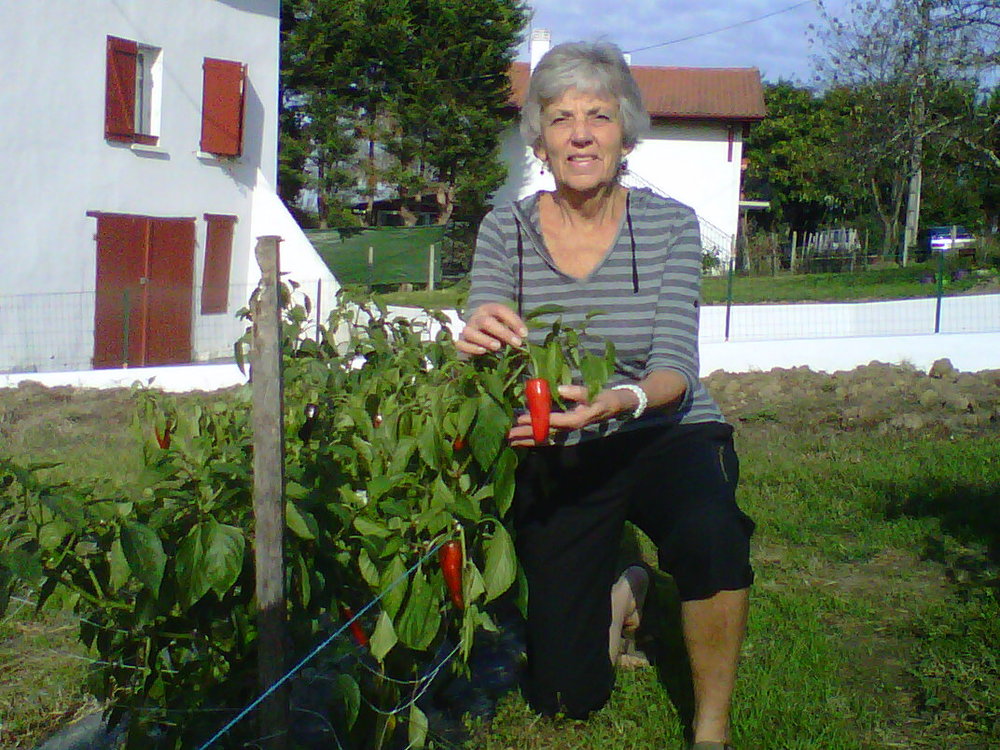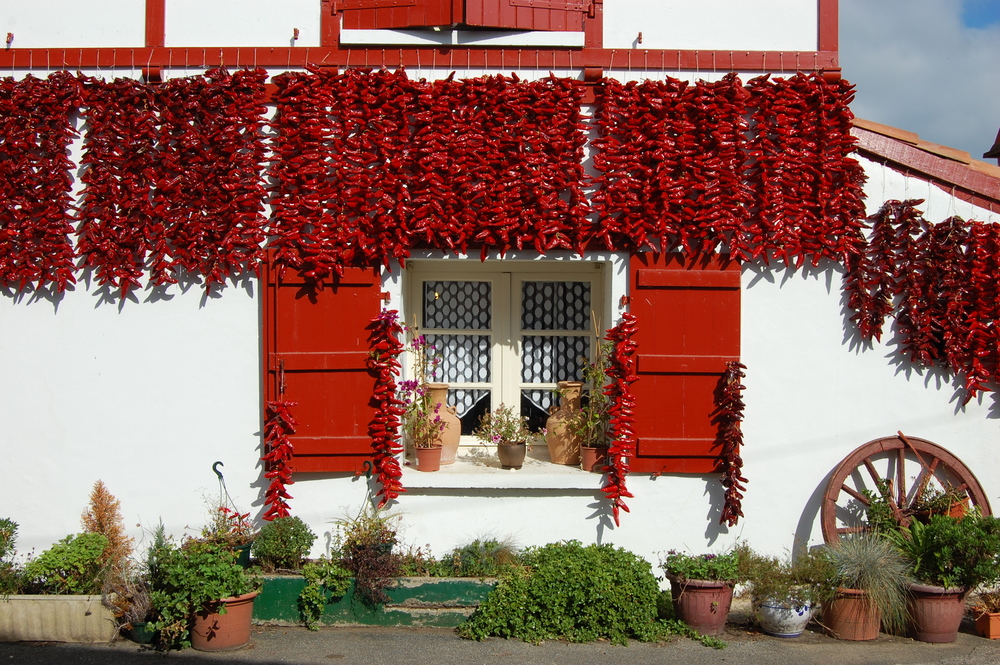

This month’s secret spice that I’ve sent to you is called Piment d’Espelette. (Please let me know if you have NOT received it). It is a ground red chili pepper that comes from the famous Basque village of Espelette. Once when my mother was visiting, we took a day trip and traveled to Espelette just to see the famous lil’ guys and to taste the wonderful hams, mustards, jams, cheeses and desserts that this pepper dresses up.
These red peppers are handpicked, tied together on ropes to form garlands, hung to dry in full sun for 2 weeks and then roasted over coals, seeded by hand and ground making this famous powder. The Basque decorate the front of their homes with these garlands for the famous “fête d”espelette” (Espelette festival) each year.
This March recipe is Poulet Basquaise which actually contains two recipes and is by far, my favorite basque dish. Basque chicken is a very simple but savory dish which includes the famous “piperade” sauce. Piperade or pepper/capernum sauce is made a day or two in advance in order for all of the fresh flavors to marry. It is cooked, reduced and then stored in the frigo. This rich, peppery sauce will be used later to baste your chicken while cooking. (Don’t let this powerful pepper scare you, its heat index is only a 3 out of 10, slightly stronger than paprika but much milder than it’s spicy cousin, habanero.)
With no further adieu, here it is…
Poulet Basquaise / Basque Chicken:
Ingredients that you will need for 4 servings:
- 4 chicken quarters, free-range if possible
- Gros Sel (kosher salt) and fresh ground black pepper
- 2 tablespoons oil (olive, coconut or sunflower)
- 2 tablespoons dark brown sugar
- 1/4 cup sherry vinegar (substitute can be rice wine vinegar)
- I heaping cup Pipérade pureed (recipe below)
- 1-2 teaspoons of Piment d’espelette (substitute can be Paprika)
- chopped flat leaf parsley for garnish
Pipérade Sauce / Red Bell Pepper sauce:
Makes 3 cups
- 1 small onion, thinly sliced lengthwise
- 1 red bell pepper, cored, seeded and cut lengthwise into 1/4 inch wide strips
- 1 yellow bell pepper, cored, seeded and cut lengthwise into 1/4 inch wide strips
- 6 garlic cloves, crushed or thinly sliced
- 4 ripe tomatoes, cored and cut rough or 1 can stewed tomatoes
- Gros sel, or kosher salt
- Piment d’Espelette (2 pinches)
Instructions:
Heat large sauté pan over medium heat, add oil and warm until it ripples. Add onion, peppers, garlic and tomatoes and cook, stirring occasionally for 10 minutes. The veggies should be soft and darker in color. Remove from heat, let it cool. Season it to your taste with salt and the piment d’espelette. You can store this up to 5 days in the frigo or freeze it. I like to can a bunch of it , when peppers are in season and cheap, and then use it throughout the year.
Cooking instructions for Poulet Basquaise with pipérade sauce:
Preheat the broiler.
Sprinkle the chicken on all sides with salt and black pepper. Heat oil in pan until it ripples and then add chicken quarters skin side down. Cook for 3-4 minutes and then flip, cooking for 3 more. While the chicken is cooking, purée your bell pepper sauce for later use. Transfer cooked chicken to a plate and discard oil.
Return the pan to high heat and add the brown sugar, stirring until it’s melted. Remove from the heat and add in the sherry vinegar. Turn heat down to medium and return pan and stir until the sherry has thickened and reduced some, about one minute. Stir in the pureed pipérade and the 1 tsp of piment d’Espelette. Return the chicken to the pan and cover, decrease heat to low, cooking 10 minutes more. When chicken is fully cooked, put them skin side up on a broiler pan and broil for 2 minutes, or just until skin is crisp.
Before serving, make sure the pipérade has enough seasoning to your liking. Does it need more salt or more spice? I personally like my basque chicken tangy and so I always add a tiny bit more vinegar before serving.
To serve, spoon a pool of the pepper sauce on each warmed plate and top with chicken quarter. Rice, braised potatoes or fries are great for sopping up the sauce!
A spanish, bold, red Navarre wine is excellent with this dish!
bon appétit!


Recent Comments